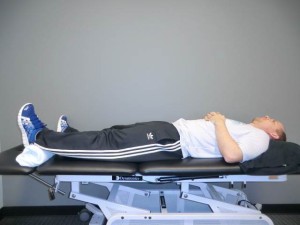Exercises Before Knee Surgery
We see many people before knee surgery for what we like to call “prehab,” or rehab exercises to prepare you for surgery. It’s interesting how there is a discrepancy even among physicians about whether or not it’s necessary to do prehabilitation before knee surgery. So what does the data tell us?
It is fairly clear from the literature that prehabilitation before total knee arthroplasty leads to better outcomes – studies here, here, here, and here support this. In the case of ACL reconstructions, a 1995 study by Cosgarea et al in the American Journal of Sports Medicine tells us that basically 4 things should be achieved prior to having an ACL reconstruction. They are:
- Minimal to no swelling. You have to get the swelling out of there as much as possible. The swelling is the principal reason why you should wait to have surgery – the knee is already “angry” from the injury and to make it more angry by operating can cause more pain and possibly more dysfunction from stiffness post-operatively. Depending on the severity of the injury, there may be a point where you’ve maximized how much you’ll actually get out of it. Ice, as much rest as possible, elevation, and compression are all ways to reduce swelling.
- Get at least 120° of knee flexion. It’s hard to know for sure how much this actually is unless a physical therapist measures you, but basically get as much bending as possible. Research has shown that if you achieve 120° of knee flexion pre-op, your risk of knee stiffness, known as arthrofibrosis, is much less. Riding an exercise bike, deep water jogging in the pool, or heel slides (Figure 1) are all good ways to do this.
- Get your leg as straight as possible. Much like knee bending, you want your knee to be as straight as possible. If you have a meniscus tear or an ACL tear, the tear may restrict this and extension could be very very painful. Do the best you can to get it straight. Heel hangs are a great way to do this (Figure 2).
- Maximize your quadriceps function by being able to do a straight leg raise. A straight leg raise (Figure 3) is a fundamental exercise post-op because if you can do it, you’ll be able to walk without a brace and you have “minimum” quad function. You have to be picky with this though – it can’t be a “bent knee raise.” We’re really particular about this exercise at SSOR, so check with us if you aren’t sure. If you try and do one and can’t keep your knee straight, quad sets (Figure 4) are a good place to start. Roll a towel up and place it under your knee and just push the back of your knee into the towel roll. A physical therapist can also put you on a muscle stimulator to help facilitate this.
Truthfully, the above are great guidelines for any knee surgery. In addition to the above, other exercises may include hip strengthening, stretching, and balance activities. Regarding those having total knee replacement, the three main issues long-term after total knee replacement are declining quadriceps strength, loss of motion, and decreasing balance. Those three items are heavily emphasized at SSOR both pre- and post-op to maximize function.
It would be a privilege to serve you and partner with you in your care prior to or after knee surgery. All indications from the research suggest that prehabilitation leads to better outcomes. Give us a call if you need exercises before knee surgery to help maximize your outcome post-operatively and put yourself in the best position to succeed.



